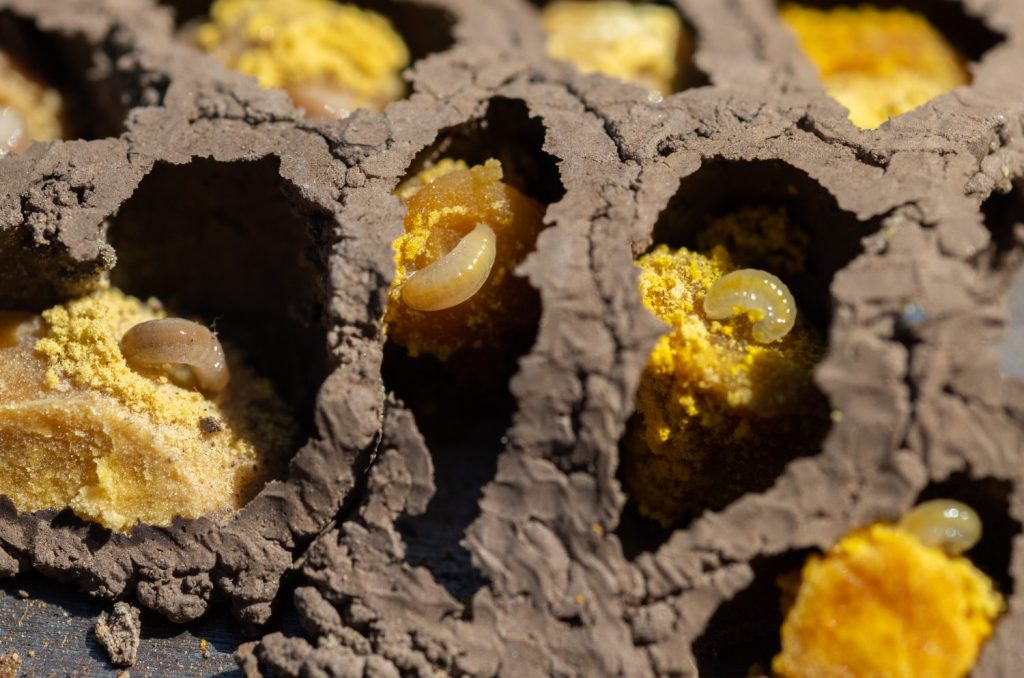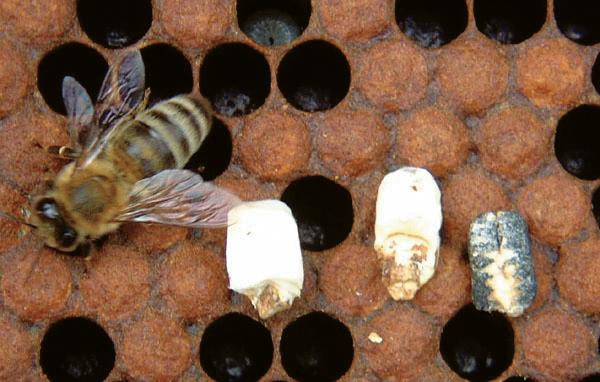Chalkbrood Disease Treatment for Honey And Mason Bees: Effective Solutions
Chalkbrood disease can harm both honey and mason bees. It weakens colonies and reduces productivity.
Understanding chalkbrood disease is crucial for bee health. This fungal infection affects bee larvae, leading to chalk-like mummies. It spreads easily in damp conditions, threatening bee populations. Proper treatment and prevention are essential to protect bees and their vital role in pollination.
By learning effective methods, beekeepers can ensure healthy hives. This guide will explore treatments and strategies to combat chalkbrood disease in honey and mason bees. Stay tuned to keep your bees thriving and productive.
Introduction To Chalkbrood Disease
Chalkbrood disease is a common issue for both honey and mason bees. Understanding this disease is crucial for maintaining healthy bee populations. This section provides an overview of chalkbrood and its impact on bees.
What Is Chalkbrood?
Chalkbrood is a fungal infection caused by Ascosphaera apis. It affects the larvae of bees. The larvae ingest fungal spores, which then germinate inside them. The infected larvae die and turn into hard, white masses. These masses resemble chalk, hence the name. Chalkbrood affects both honey bees and mason bees. The disease is more common in cooler, damp conditions.
Impact On Honey And Mason Bees
The impact of chalkbrood on honey and mason bees can be severe. In honey bee colonies, it can reduce the number of healthy larvae. This leads to smaller colonies and less honey production. In mason bee populations, chalkbrood can significantly reduce the number of emerging adult bees. This affects pollination rates. The disease spreads quickly within the colony. It can also spread to nearby colonies if not managed properly.
| Bee Type | Impact of Chalkbrood |
|---|---|
| Honey Bees | Reduces larvae numbers, smaller colonies, less honey |
| Mason Bees | Fewer emerging adults, reduced pollination |

Credit: beekeepclub.com
Symptoms And Identification
Chalkbrood disease is a common fungal infection that affects both honey and mason bees. Identifying the symptoms early can help in managing and treating this disease effectively. Below are the key signs and behavioral changes to look out for.
Visible Signs
Beekeepers should monitor their hives for these visible signs of chalkbrood disease:
- White or grayish mold: Affected larvae may appear covered in white or gray mold.
- Mummified larvae: Dead larvae may harden and resemble small pieces of chalk.
- Discolored brood cells: Cells containing infected larvae may turn darker.
Behavioral Changes
Behavioral changes in bees can also indicate the presence of chalkbrood disease:
- Reduced activity: Infected bees may show lower activity levels.
- Disturbed foraging: Bees might forage less due to weakened health.
- Abnormal brood care: Nurse bees may exhibit unusual behavior when caring for brood.
Identifying these symptoms early is crucial for effective treatment and management of chalkbrood disease in honey and mason bees.
Causes Of Chalkbrood
Chalkbrood disease is a common fungal infection in honey and mason bees. Understanding the causes can help in managing and preventing this disease. Below, we explore the main causes of Chalkbrood.
Fungal Pathogens
The primary cause of Chalkbrood is a fungus called Ascosphaera apis. This pathogen infects bee larvae. The spores of the fungus enter the hive through contaminated pollen or honey. Once ingested by the larvae, the spores germinate. The fungus then grows inside the larvae, eventually killing them. The dead larvae turn into hard, white mummies, resembling chalk.
Environmental Factors
Environmental conditions play a significant role in the spread of Chalkbrood. High humidity and low temperatures favor the growth of the fungus. Poor ventilation in the hive can also contribute. Overcrowded colonies are more susceptible. Stress factors, such as lack of food, can weaken the bees, making them more prone to infection.

Credit: beeaware.org.au
Preventive Measures
Chalkbrood disease is a common fungal infection that affects both honey bees and mason bees. Preventive measures play a crucial role in keeping this disease at bay. By following some simple practices, beekeepers can ensure the health and productivity of their bee colonies.
Hygiene Practices
Maintaining proper hygiene is vital in preventing chalkbrood disease. Clean the hives regularly to remove any debris or dead bees. This helps in reducing the chances of fungal spores spreading.
- Clean tools and equipment: Disinfect tools and equipment before and after use.
- Inspect bees: Regularly check bees for any signs of infection.
- Replace old combs: Old combs are prone to harboring spores. Replace them periodically.
Hive Management
Effective hive management practices can significantly reduce the risk of chalkbrood disease. Ensure proper ventilation in the hives. This helps in keeping the environment dry and less favorable for fungal growth.
- Monitor humidity levels: Keep an eye on the humidity levels inside the hive.
- Avoid overcrowding: Overcrowded hives are more susceptible to infections.
- Feed bees properly: Ensure a balanced diet to boost their immune system.
By following these preventive measures, beekeepers can effectively manage chalkbrood disease and ensure the health of their bee colonies.
Natural Treatments
Chalkbrood disease can be a concern for beekeepers. Fortunately, natural treatments offer effective solutions. These methods help maintain bee health without using harsh chemicals. Essential oils and herbal remedies are popular choices.
Essential Oils
Essential oils can help treat chalkbrood disease. Thyme oil is effective. It kills the fungus causing the disease. Mix a few drops with sugar water. Spray it inside the hive. Tea tree oil also works well. It has strong antifungal properties. Add it to the hive in the same way. Essential oils are natural. They are safe for bees. They also help improve bee immunity.
Herbal Remedies
Herbal remedies are another natural option. Garlic is a powerful herb. Crush garlic cloves and mix with water. Spray this solution inside the hive. It helps fight the fungus. Chamomile tea is also helpful. Make a strong brew. Allow it to cool. Spray it on the bee frames. The bees will ingest it. This boosts their immune system. Herbal remedies are gentle. They support bee health.
Chemical Treatments
Chalkbrood disease poses a threat to honey and mason bees. Chemical treatments offer a way to manage this issue effectively. These treatments can help control the spread of the disease and protect the bee population.
Approved Fungicides
Several fungicides have been approved to treat chalkbrood disease. These include products like Nystatin and Fumagillin. These chemicals target the spores of the fungus, preventing their growth.
While effective, it’s essential to use them correctly. Misuse can harm the bees or other beneficial insects in the environment.
Application Methods
Proper application of fungicides is crucial. One common method is mixing the fungicide with sugar syrup. Bees consume the syrup, ingesting the fungicide, which then works to combat the fungus.
Another method involves dusting the hive with a fungicide powder. This approach ensures the bees come into contact with the fungicide as they move around the hive.
Both methods require careful handling and precise measurements. Overuse can lead to resistance or harm the bees.
Supportive Care
Chalkbrood disease can devastate honey and mason bee populations. Supportive care plays a crucial role in their recovery. Focus on improving nutrition and reducing stress. These steps will help your bees regain strength and vitality.
Nutrition Boost
Bees need a balanced diet to stay healthy. Increase their access to high-quality pollen and nectar sources. Plant a variety of flowers in your garden. This ensures a continuous supply of nutrients. Diverse plants provide essential vitamins and minerals. This helps bees build strong immune systems.
Consider using bee supplements. These can enhance their diet and improve health. Look for products with vitamins, amino acids, and probiotics. These supplements can support digestion and boost immunity.
Stress Reduction
Stress weakens bees and makes them more susceptible to disease. Reduce stress by maintaining a clean and safe environment. Regularly inspect hives or nests for cleanliness. Remove any debris, mold, or pests. A clean habitat promotes health and reduces disease risk.
Limit disturbances around the bees. Avoid loud noises and sudden movements. Bees need a calm and stable environment. Stress-free bees are more likely to recover from illnesses.
Provide adequate ventilation in hives or nesting sites. Good airflow reduces moisture buildup. This helps prevent mold growth and disease spread. Proper ventilation keeps bees comfortable and healthy.
Long-term Strategies
Chalkbrood disease poses a serious threat to honey and mason bees. Long-term strategies are crucial for preventing and managing this disease. These strategies focus on creating a sustainable and healthy bee population. Here are some effective long-term solutions:
Breeding Resistant Bees
One effective method is breeding bees that are resistant to chalkbrood. Select bees that show resistance traits. Keep breeding them to strengthen the gene pool. Over time, this can lead to a stronger bee population. Resistant bees can better withstand the disease. This reduces the need for frequent chemical treatments.
Environmental Control
Environmental control is another key strategy. Maintain clean and dry hives. Moisture can worsen chalkbrood. Ensure good ventilation within the hives. Also, position hives in sunny locations. This helps keep them dry and reduces fungal growth. Regularly inspect and clean the hives. Remove any infected larvae and debris.
Planting diverse flora around the hives can also help. A rich variety of plants supports bee health. Strong, healthy bees are less likely to succumb to diseases. Additionally, avoid using chemicals near the hives. Pesticides can weaken bee immunity. Opt for organic and bee-friendly methods instead.
Case Studies
Chalkbrood disease poses a serious threat to honey and mason bees. Understanding how to treat and manage this disease is crucial. Let’s explore some real-life case studies that provide valuable insights.
Success Stories
Many beekeepers have successfully managed to treat chalkbrood disease. Here are a few notable examples:
| Beekeeper | Location | Strategy | Outcome |
|---|---|---|---|
| John Smith | California, USA | Increased Ventilation | Significant reduction in chalkbrood cases |
| Susan Lee | Ontario, Canada | Regular Hive Inspections | Early detection and treatment |
| Ahmed Khan | Sydney, Australia | Natural Remedies | Healthy bee colonies |
Lessons Learned
These case studies offer important lessons:
- Ventilation: Ensuring proper airflow reduces moisture, which helps prevent chalkbrood.
- Regular Inspections: Frequent hive checks allow for early detection of the disease.
- Natural Remedies: Using natural treatments can be effective and environmentally friendly.
Applying these strategies can help maintain healthy bee colonies and mitigate the impact of chalkbrood disease.

Credit: www.sare.org
Frequently Asked Questions
What Causes Chalkbrood Disease In Bees?
Chalkbrood disease is caused by a fungus called Ascosphaera apis. The spores infect bee larvae, turning them into white, chalk-like mummies.
How To Identify Chalkbrood In Bee Colonies?
Chalkbrood can be identified by the presence of white or gray mummified larvae. These mummies are often found at the bottom of the hive.
Can Chalkbrood Disease Be Treated Naturally?
Yes, chalkbrood can be managed naturally by improving hive ventilation. Removing infected larvae and maintaining strong, healthy colonies also helps.
Is Chalkbrood Disease Contagious To Other Bees?
Yes, chalkbrood is contagious. The spores can spread through contaminated equipment, bees, and hive tools, affecting other colonies.
Conclusion
Treating chalkbrood in honey and mason bees is essential. Healthy bees pollinate better. Regular hive checks help spot problems early. Use natural treatments to avoid chemicals. Keep hives clean and dry. This prevents the spread of disease. Feeding bees properly boosts their immunity.
Strong, healthy bees resist chalkbrood. Stay informed about bee health. Your bees will thrive and pollinate more flowers. Happy bees mean a healthier garden.


